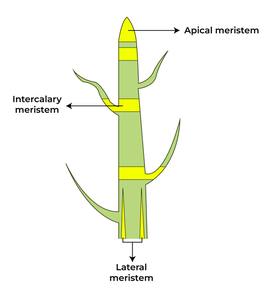What is Meristematic Tissue? Definition, Types, Characteristics
Introduction to Meristematic Tissue
In simple, Meristematic tissue is a unique and vital component of plant anatomy. It plays a crucial role in plant growth and development. In this article, we will explore the definition and characteristics of meristematic tissue, as well as delve into its various types based on origin, position, and function.
What is Meristematic Tissue?
Meristematic tissue, also known as meristem, refers to a group of actively dividing cells found in plants. These cells possess the remarkable ability to continuously divide and differentiate into various specialized cells, which ultimately contribute to plant growth and development.
Does it look complex? Let us understand in another way. Meristematic tissue might sound complex, but it’s the superhero of plant tissues. Think of it as the engine that powers a plant’s growth. In simpler terms, meristematic tissue is a group of cells responsible for the growth of plants. This tissue is like the construction crew in charge of building a plant’s body.
Meristematic Tissue Diagram
The diagram of Meristematic Tissue is given below,

Structure of Meristematic Tissue
Meristematic tissue is made up of specialized cells, and these cells are like the building blocks of a plant. Here’s how they are structured:
- Small and Cuboidal: Meristematic cells are usually tiny and have a cube-like shape.
- Thin Cell Walls: Their cell walls are very thin, allowing for easy division and growth.
- No Vacuoles: Unlike other plant cells, they have minimal or no vacuoles, which are like storage containers in plant cells.
- Nucleus-Centric: These cells have a large nucleus, which controls cell division and growth.
Now that we know how meristematic tissue is structured, let’s talk about the different types.
Types of Meristematic Tissue
Meristematic tissue can be classified into three main types based on their origin, position, and function.
Meristematic Tissue based on Origin
- Apical Meristem: Apical Meristem is located at the tips of shoots and roots, and it is responsible for primary growth in plants. This meristem allows plants to grow longer in height and helps in the formation of new leaves, branches, and flowers.
- Intercalary Meristem: Intercalary Meristem is found in the internodes of grasses and certain monocots. It aids in the elongation of stems and leaves, contributing to the regrowth of damaged plant parts.
Meristematic Tissue based on Position
- Lateral Meristem: Lateral meristem, also known as cambium, is located in the lateral regions of plant stems and roots. It is responsible for secondary growth, which leads to the thickening of stems and roots, providing structural support and increasing girth.
- Intercalary Meristem: As mentioned earlier, intercalary meristem is situated in the internodes of grasses and monocots.
Meristematic Tissue Based on Function
- Protoderm: Protoderm is the primary meristem responsible for the formation of the epidermal layer, which covers the surface of plant organs like leaves, stems, and roots.
- Ground Meristem: Ground Meristem gives rise to the ground tissue system, including parenchyma, collenchyma, and sclerenchyma cells.
- Procambium: Procambium differentiates into the vascular tissue system, comprising the xylem and phloem, which are responsible for the transport of water, minerals, and food throughout the plant.
Characteristics of Meristematic Tissue
Meristematic tissue possesses several distinct characteristics that differentiate it from other types of plant tissues.
- Actively dividing cells: The cells in meristematic tissue divide rapidly, facilitating continuous growth and development in plants.
- Small and compact structure: Meristematic tissue is densely packed, with cells closely arranged to maximize growth potential.
- No intercellular spaces: Unlike other plant tissues, meristematic tissue lacks intercellular spaces, allowing for direct cell-to-cell communication and coordinated growth.
- Undifferentiated cells: The cells in meristematic tissue are undifferentiated, as they have not yet specialized into specific cell types.
- Rich in cytoplasm and nucleus: Meristematic cells contain a significant amount of cytoplasm and a large nucleus, providing the necessary resources for cellular division and growth.
Conclusion
In conclusion, meristematic tissue is like the engine of a plant’s growth, and it comes in different types based on its location, origin, and function. These tiny, rapidly dividing cells are essential for a plant’s development, allowing it to grow both in length and width. Remember, meristematic tissue is like a superhero in the world of plants, always working behind the scenes to ensure plants keep growing and thriving.
We hope that this article clears up all your queries on this meristematic tissue. If you want to learn similar kinds of concepts simply, you can check it out on our Tutoroot blog section. If you are looking for the best online tuition platform to improve your academic performance, then Tutoroot will be the best option for you. Click here now to book a FREE DEMO from the industry’s best faculty.
Explore the informative biology blogs available on the Tutoroot website to enhance your understanding of key concepts. With Tutoroot’s top biology online tuition classes, you can tailor your learning experience to suit your individual needs and pace. Whether you’re looking for extra practice or a deeper understanding, Tutoroot offers customized lessons designed just for you. Begin your learning journey with a FREE DEMO session, giving you a firsthand look at how one on one online tuition platform can improve your skills. Experience the advantages of having a dedicated tutor by your side, helping you to master Biology more engagingly and effectively.
FAQ’s
What is a meristematic tissue example?
Examples of meristematic tissue include the apical meristem found at the tips of shoots and roots, as well as the cambium in the lateral regions of stems and roots.
What is the function of meristematic tissue?
The main function of meristematic tissue is to actively divide and differentiate into specialized cells, contributing to primary and secondary growth in plants. This tissue produces new cells for the formation of various plant organs and tissues, ensuring continuous growth and development.
